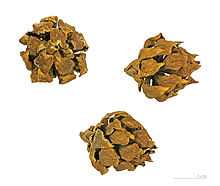Athrotaxis selaginoides
| Athrotaxis selaginoides | |
|---|---|
| | |
| Conservation status | |
| Scientific classification | |
| Kingdom: | Plantae |
| Division: | Pinophyta |
| Class: | Pinopsida |
| Order: | Pinales |
| Family: | Cupressaceae |
| Genus: | Athrotaxis |
| Species: | A. selaginoides |
| Binomial name | |
| Athrotaxis selaginoides D.Don | |

Athrotaxis selaginoides is a species of Athrotaxis, endemic to Tasmania in Australia, where it grows at 400–1,120 m altitude. In its habitat in the mountains, snow in winter is very usual. It is often called King Billy Pine or King William Pine (believed to be in reference to the Tasmanian aborigine William Lanne),[1] although it is not a true pine.[2][3]
It is an evergreen coniferous tree growing to 20–30 m tall, with a trunk up to 1.5 m diameter. The leaves are claw-like, 7–18 mm long and 3–4 mm broad, arranged spirally on the shoots. The seed cones are globose, 15–30 mm diameter, with 20–30 spirally-arranged scales; they are mature about six months after pollination. The pollen cones are 4–5 mm long.[2]
The species is threatened, with the major cause of decline being out-of-control bushfires set to clear logging debris after timber harvests in nearby Eucalyptus forests; about a third of the species' range has been lost due to fires in the 20th century. Although most of the native stands are now in protected areas, fire still remains a serious risk to the species. Logging for its timber has also caused some decline.[2]
Away from its native range, it is occasionally cultivated as an ornamental tree in northwestern Europe.[4] It succeeds in Scotland where it receives the necessary rainfalls for its good growth[5] and produces fertile seeds there.[6]
References
- ↑ "Native Conifers of Tasmania". Parks and Wildlife Service Tasmania. 17 July 2008. Retrieved 9 August 2011.
- ↑ 2.0 2.1 2.2 Farjon, A. (2005). Monograph of Cupressaceae and Sciadopitys. Royal Botanic Gardens, Kew. ISBN 1-84246-068-4
- ↑ Conifer Specialist Group 2000: Athrotaxis selaginoides
- ↑ Mitchell, A. F. (1974). A Field Guide to the Trees of Britain and Northern Europe. Collins ISBN 0-00-212035-6
- ↑ Mitchell. A. F. Conifers in the British Isles. HMSO 1975 ISBN 0-11-710012-9. A bit out of date (first published in 1972), but an excellent guide to how well the various species of conifers grow in Britain giving locations of trees.
- ↑ Huxley. A. The New RHS Dictionary of Gardening. 1992. MacMillan Press 1992 ISBN 0-333-47494-5. Excellent and very comprehensive, though it contains a number of silly mistakes. Readable yet also very detailed.
